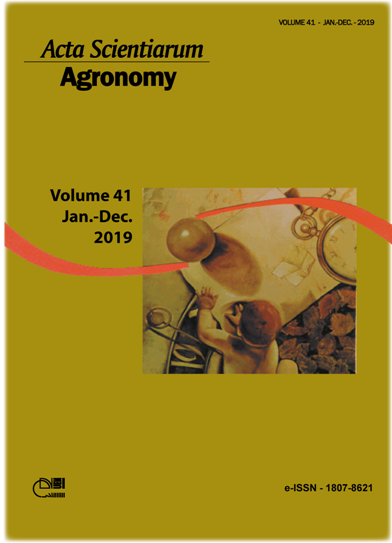Selection of melon genotypes with resistance to <i>Didymella bryoniae</i> using a diallel approach
Resumo
The development of melon lines resistant to gummy stem blight (GSB) is an important strategy for decreasing losses caused by this disease. Thus, selecting the best parents for such a goal is essential. We evaluated the general (GCA) and specific (SCA) combining abilities of lines and accessions to guide the selection of the most promising parents to develop GSB-resistant lines. Six genotypes representing two groups (group I - susceptible: group II - resistant) were crossed in a partial diallel mating design. The genotypes were evaluated for disease expression using a rating scale from 0 (resistant) to 4 (susceptible). Estimates of GCA were negative and significant for the accessions PI 420145 and PI 482398, which can be suggested for crosses aimed at obtaining melon lines resistant to GSB. There is a reciprocal effect for the resistance of melon genotypes to Didymella bryoniae, especially when PI 482398, PI 420145, and PI 140471 are crossed with JAB-20. Such results indicate that maternal effects may be involved in the resistance to gummy stem blight.
Downloads
Referências
Amand, P. C. S., & Wehner, T. C. (2001). Generation means analysis of leaf and stem resistance to gummy stem blight in cucumber. Journal of the American Society for Horticultural Science, 126(1), 95-99.
Andrade, M. C., Silva, A. A., Conrado, T. V., Maluf, W. R., Andrade, T. M., & Oliveira, C. M. (2014). Capacidade combinatória de linhagens de tomateiro em híbridos do tipo italiano. Bragantia, 73(3), 237-245. DOI: 10.1590/1678-4499.0039
Beker, R. J. (1978). Issues in diallel analysis. Crop Science, 18(4), 533-536. DOI: 10.2135/cropsci1978.0011183X001800040001x
Cardon, C. H., Santos, G. R., Tschoeke, P. H., Ságio, S. A., Dalcin, M. S., & Aguiar, R. W. S (2016). Eficácia de fungicidas associados a inseticidas sobre o crestamento gomoso do caule e produtividade do meloeiro. Summa Phytopathologica, 42(1), 79-84. DOI: 10.1590/0100-5405/2019
Cruz, C. D. (2013). GENES - A software package for analysis in experimental statistics and quantitative genetics. Acta Scientiarum. Agronomy, 35(3), 271-276. DOI: 10.4025/actasciagron.v35i3.21251
Engelsing, M. J., Rozzetto, D. S., Coimbra, J. L. M., Zanin, C. G., & Guidolin, A. F. (2011). Capacidade de combinação em milho para resistência a Cercospora zeae-maydis. Revista Ciência Agronômica, 42(1), 232-241. DOI: 10.1590/S1806-66902011000100029
Gasparotto, F., Vida, J. B., Tessmann, D. J., Bonaldo, S. M., Aguiar, R. L., & Penharbel, M. P. (2009). Eficiência de métodos para detecção de Didymella bryoniae associado a sementes de híbridos de meloeiros nobres. Acta Scientiarum. Agronomy, 31(3), 397-402. DOI: 10.4025/actasciagron.v31i3.360
Gasparotto, F., Vida, J. B., Tessmann, D. J., & Alves, T. C. A. (2011). Infecção latente de Didymella bryoniae em meloeiro nobre. Summa Phytopathologica, 37(1), 62-64. DOI: 10.1590/S0100-54052011000100010
Geraldi, I. O., & Miranda, Filho, J. B. (1988). Adapted models for the analysis of combining ability of varieties in partial diallel crosses. Revista Brasileira de Genética, 11(2), 419-430.
Griffing, B. (1956). Concept of general and specific combining ability in relation to diallel crossing systems. Australian Journal of Biological Sciences, 9(1), 463-493.
Keinath, A. P. (2011). From native plants in Central Europe to cultivated crops worldwide: the emergence of Didymella bryoniae as a cucurbit pathogen. HortScience, 46(4), 532-535.
Keinath, A. P. (2015). Baseline sensitivity of Didymella bryoniae to cyprodinil and fludioxonil and field efficacy of these fungicides against isolates resistant to pyraclostrobin and boscalid. Plant Disease, 99(6), 815-822. DOI: 10.1094/PDIS-09-14-0993-RE
Krause, W., Rodrigues, R., & Leal, N. R. (2012). Capacidade combinatória para características agronômicas em feijão de vagem. Revista Ciência Agronômica, 43(3), 522-531.
Nogueira, D. W., Maluf, W. R., Figueira, A. R., Maciel, G. M., Gomes, L. A. A., & Benavente, C. A. T. (2011). Combining ability of summer-squash lines with different degrees of parthenocarpy and PRSV-W resistance. Genetics and Molecular Biology, 34(4), 616-623. DOI: 10.1590/S1415-47572011005000039
Pádua, T. R. P., Gomes, L. A. A., Maluf, W. R., Carvalho Filho, J. L. S., Gonçalves Neto, A. C., & Andrade, M. C. (2010). Capacidade combinatória de híbridos de tomateiro de crescimento determinado, resistentes a Begomovirus e Tospovirus. Pesquisa Agropecuária Brasileira, 45(8), 818 825. DOI: 10.1590/S0100-204X2010000800007
Ramalho, M. P., Santos, J. B. D., Pinto, C. A. B. P., Souza, E. A., Gonçalves, F. M. A., & Souza, J. C. D. (2012). Genética na agropecuária. Lavras, MG: Editora UFLA.
Rocha, F., Stinghen, J. C., Gemeli, M. S., Coimbra, J. L. M., & Guidolin, A. F. (2014). Análise dialélica como ferramenta na seleção de genitores em feijão. Revista Ciência Agronômica, 45(1), 74-81.
Santos, G. R., Leão, E. U., Garcia, M. M. V., Maluf, W. R., Cardon, C. H., Gonçalves, C. G., & Nascimento, I. R. (2013). Reação de genótipos experimentais de melancia ao crestamento gomoso do caule. Horticultura Brasileira, 31(4), 540-548. DOI: 10.1590/S0102-05362013000400006
Vargas, P. F., Galatti, F. S., Souza, J. O., Castoldi, R., Charlo, H. C. O., & Braz, L. T. (2010). Avaliação de parentais e híbridos experimentais de melão rendilhado. Ciência e Agrotecnologia, 34(5), 1102-1108. DOI: 10.1590/S1413-70542010000500004
Wu, H. X., & Matheson, A. (2001) Reciprocal, maternal and non-maternal effects in radiata pine diallel mating experiment on four Australia sites. Forest Genetics, 8(3), 205-212.
DECLARAÇÃO DE ORIGINALIDADE E DIREITOS AUTORAIS
Declaro que o presente artigo é original, não tendo sido submetido à publicação em qualquer outro periódico nacional ou internacional, quer seja em parte ou em sua totalidade.
Os direitos autorais pertencem exclusivamente aos autores. Os direitos de licenciamento utilizados pelo periódico é a licença Creative Commons Attribution 4.0 (CC BY 4.0): são permitidos o compartilhamento (cópia e distribuição do material em qualqer meio ou formato) e adaptação (remix, transformação e criação de material a partir do conteúdo assim licenciado para quaisquer fins, inclusive comerciais.
Recomenda-se a leitura desse link para maiores informações sobre o tema: fornecimento de créditos e referências de forma correta, entre outros detalhes cruciais para uso adequado do material licenciado.




















































